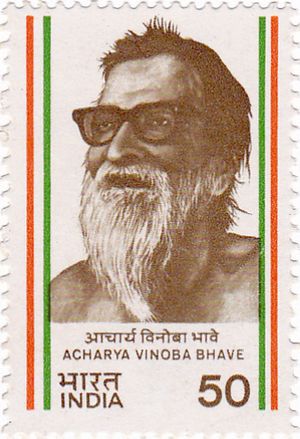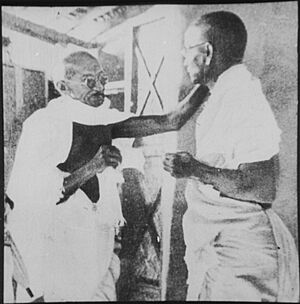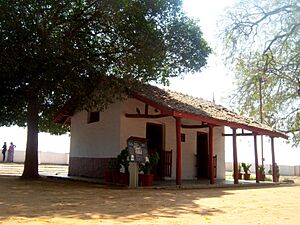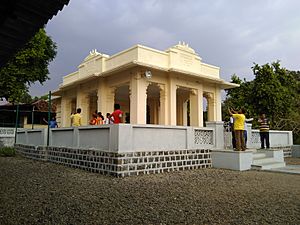Vinoba Bhave facts for kids
Quick facts for kids
Acharya
Vinoba Bhave
विनोबा भावे |
|
|---|---|

Bhave on a 1983 stamp of India
|
|
| Born |
Vinayak Narahari Bhave
11 September 1895 |
| Died | 15 November 1982 (aged 87) Pavnar, Wardha, Maharashtra, India
|
| Nationality | • • |
| Other names | Acharya |
| Alma mater | Maharaja Sayajirao University of Baroda |
| Known for | Individual Satyagraha, Bhoodan Movement |
| Honours | Ramon Magsaysay Award (1958) Bharat Ratna (1983) |
Vinayak Narahari Bhave, known as Vinoba Bhave (born September 11, 1895 – died November 15, 1982), was an important leader in India. He believed strongly in nonviolence, which means solving problems without fighting. He also worked for human rights, making sure everyone was treated fairly.
People often called him Acharya, which means 'Teacher' in Sanskrit. He is most famous for starting the Bhoodan Movement, a special project where he asked people to donate land for the poor. Many see him as a national teacher for India and a spiritual follower of Mahatma Gandhi. He was also a great thinker and writer. He translated the holy book Gita into the Marathi language, calling it Geetai, meaning 'Mother Gita'.
Contents
Early Life and Education
Vinayak Narahari Bhave was born on September 11, 1895. His birthplace was a small village called Gagode in the Konkan region of what is now Maharashtra, India. He was the oldest of five children. His father worked in Baroda, and his mother, Rukmini Devi, was a very religious woman.
Vinayaka was raised by his grandfather. He was greatly inspired by his mother's religious beliefs. From a very young age, he loved reading the Bhagavad Gita, a sacred Hindu scripture.
Meeting Mahatma Gandhi
In 1916, Vinayaka read about a speech given by Mahatma Gandhi. This speech really caught his attention. On his way to Mumbai for an exam, he decided to throw away his school certificates. He felt inspired by Gandhi's ideas.
He wrote a letter to Gandhi, and after exchanging a few letters, Gandhi invited him to meet. Vinayaka met Gandhi on June 7, 1916. After this meeting, he decided to stop his formal studies. He joined Gandhi's ashram, a spiritual community, in Ahmedabad.
Life at the Ashram
At Gandhi's ashram, Vinayaka was very involved. He helped with teaching, studying, and spinning cloth. He also worked to improve the lives of people in the community. He took part in Gandhi's projects. These included promoting Khadi (handmade cloth), village industries, and new ways of education. He also helped with sanitation and hygiene.
In 1921, Gandhi asked Vinayaka to take charge of the ashram in Wardha. In 1923, he started a Marathi magazine called Maharashtra Dharma. It featured his essays on spiritual topics. This magazine later became a weekly publication. In 1925, Gandhi sent him to Kerala. His task was to help Dalit people enter temples, which was not allowed for them at the time.
Freedom Struggle and Imprisonment
Vinoba Bhave was arrested many times in the 1920s and 1930s. He even spent five years in jail in the 1940s. This was because he led peaceful protests against British rule in India. For Bhave, jails became places for reading and writing. He wrote several books while in prison. He also learned four South Indian languages.
While in jail, he gave talks about the Bhagavad Gita to other prisoners. These talks were later published as a book called Talks on the Gita. It has been translated into many languages. Bhave believed these talks came from a higher source. He felt their message would last forever.
Bhave took part in the nationwide protests against the British. He became well-known when Gandhi chose him for a new nonviolent campaign in 1940. People started calling him by his short name, Vinoba.
He lived for some time at Gandhi's Sabarmati ashram. There was a small house there named 'Vinoba Kutir' after him. In 1940, Gandhi chose him as the first "individual Satyagrahi." This meant he was the first person to stand up for truth peacefully on his own. Gandhi respected Bhave's vow of celibacy, which he made when he was young. Bhave also joined the Quit India Movement, a major protest against British rule.
Social and Spiritual Work
Vinoba Bhave had a very open view on religion. He believed in the truths found in many different faiths. His hymn "Om Tat Sat" includes symbols from various religions. His slogan "जय जगत्" (Jay Jagat), meaning "victory to the world," showed his global outlook.

Bhave studied the lives of ordinary people in villages. He tried to find solutions to their problems based on spiritual ideas. This was the main goal of his Sarvodaya Movement. This movement aimed for the well-being of all people.
The Bhoodan Movement
One of his most famous projects was the Bhoodan (land gift) movement. He started it on April 18, 1951, in Pochampally. He had talked with 80 families who did not own land. He then walked all over India, asking people who owned land to share it. He asked them to give him one-sixth of their land. He then gave this land to poor people who had no land to farm.
After 1954, he began asking for entire villages as donations. He called this program Gramdan (village gift). He received more than 1,000 donated villages. Out of these, 175 villages were in Tamil Nadu alone. Non-violence and kindness were key parts of his beliefs. He also worked to stop the killing of cows.
Bhave once said, "I have walked all over India for 13 years. I have set up 6 ashrams, which will continue my life's work."
Brahma Vidya Mandir
The Brahma Vidya Mandir is one of the ashrams Vinoba Bhave started. It is a small community mainly for women. It was created to help women become self-sufficient and live peacefully. This group grows its own food. They follow Gandhi's ideas about food production, which focus on being sustainable and fair to everyone.
This community is greatly influenced by the Bhagavad-Gita. Its teachings guide their daily practices. The community prays together every day. They recite from the Isha Upanishad in the morning and the Bhagavad-Gita in the evening. Today, about 25 women are part of this community, and some men have also joined.
The Brahma Vidya Mandir shows how a community can live by values like self-sufficiency and non-violence. They prove that success in farming does not always need expensive technology.
Literary Contributions
Vinoba Bhave was a talented scholar, thinker, and writer. He wrote many books. He translated Sanskrit texts so that ordinary people could understand them. He was also a great speaker and knew many languages. These included Marathi, Kannada, Hindi, English, and Sanskrit.
He wrote short introductions and thoughts on religious and philosophical works. These included the Bhagavad Gita, works by Adi Shankaracharya, the Bible, and the Quran. His thoughts on the poetry of Dnyaneshwar and other Marathi saints were very insightful.
Bhave had translated the Bhagavad Gita into Marathi. He was deeply affected by the Gita's teachings. He tried to live by them every day, often saying, "The Gita is my life's breath."
Vinoba Bhave University, located in Jharkhand, is named after him.
Later Life and Legacy
Vinoba Bhave spent his later years at his Brahma Vidya Mandir ashram in Paunar. He passed away on November 15, 1982. He chose to stop eating and taking medicine, a practice known as "Samadhi Maran" or "Santhara" in Jainism. At the time, India's Prime Minister, Indira Gandhi, cut short her trip to Moscow to attend his funeral.
Criticism
Like many public figures, Vinoba Bhave faced some criticism. Some people felt he copied Gandhi too much. A more debated point was his support for the government during a difficult period in India. He called this time Anushasana Parva, meaning 'Time for Discipline'. Some people disagreed with his views and even called him a "Government Saint."
Awards and Recognition
In 1958, Vinoba Bhave was the first person to receive the international Ramon Magsaysay Award for Community Leadership. This award recognized his work in helping communities. After his death, in 1983, he was given the Bharat Ratna, India's highest civilian award.
Two documentary films have been made about Vinoba Bhave. Vinoba Bhave, The Man was released in 1963. An earlier film, Vinoba Bhave, was made in 1951.
See also
- List of peace activists
- Mohandas Karamchand Gandhi
- Gandhism
- Lanza del Vasto
- Shakuntala Choudhary



